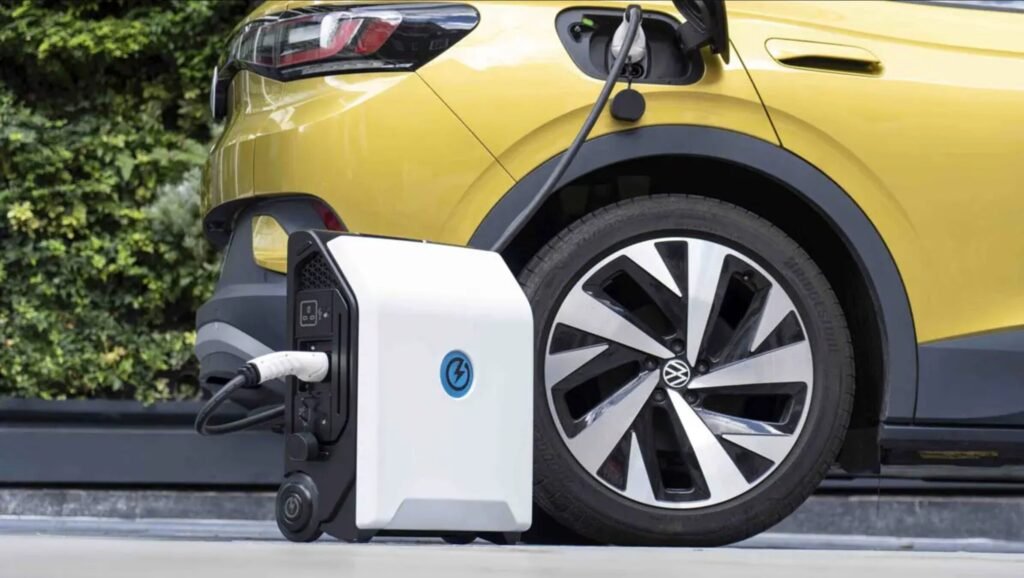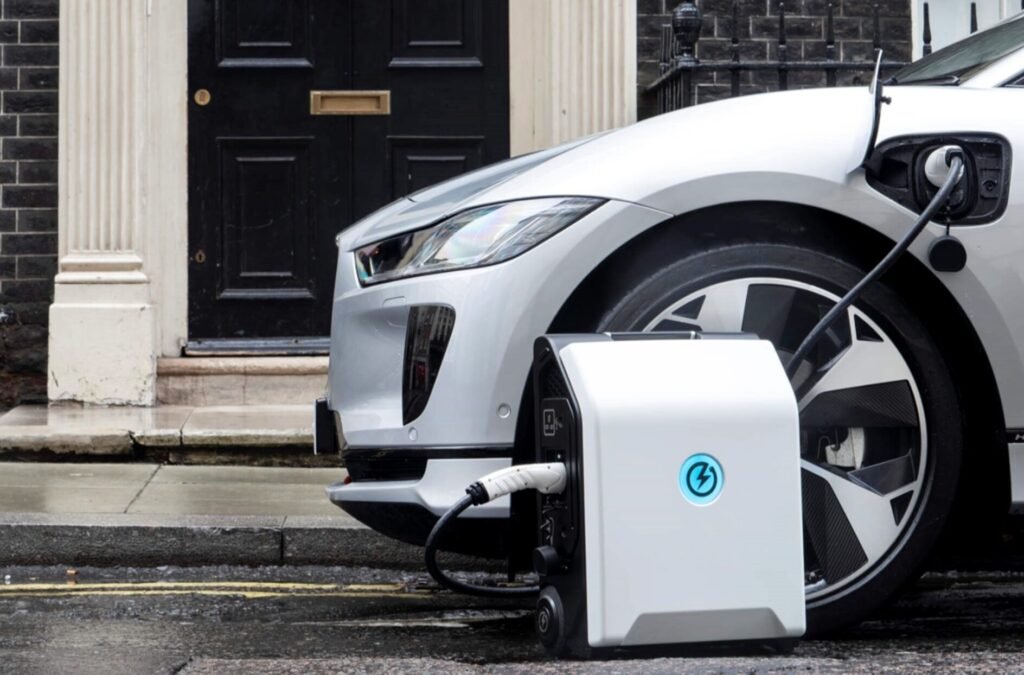As electric vehicles (EVs) continue to reshape modern transportation, one challenge remains top of mind for drivers: charging accessibility. While public charging infrastructure is expanding rapidly, there are still situations where you might need a backup — like during road trips, emergencies, or off-grid adventures. That’s where the portable EV charging station steps in.

A portable EV charger offers the freedom to charge your car anytime, anywhere, without relying on fixed stations. From compact plug-in models to heavy-duty battery-powered units, these devices are quickly becoming a must-have for EV owners who value flexibility and peace of mind.
This article explores everything you need to know about portable EV charging stations — how they work, their benefits, real-world examples, challenges, and the role they’ll play in the future of sustainable mobility.
What Is a Portable EV Charging Station?
A portable EV charging station is a compact, mobile device designed to charge electric vehicles without depending solely on fixed infrastructure. Unlike standard wall-mounted home chargers or public stations, these portable units can be carried in the trunk and used wherever a power source is available.
Most models plug directly into standard wall outlets, RV hookups, or even portable power banks. Advanced versions include built-in batteries that act as mobile power units, allowing EV owners to recharge on the go — even in remote locations.
According to Wikipedia’s page on electric vehicles, EVs rely on rechargeable battery packs that can only operate when adequately charged. Portable charging solutions help bridge this critical gap, ensuring drivers aren’t stranded with a depleted battery.
Types of Portable EV Chargers

- Level 1 Chargers – Plug into standard 120V outlets; slower charging speed, but great for emergencies.
- Level 2 Chargers – Require 240V outlets (like those used for dryers or RVs); offer faster charging times.
- Battery-Powered Units – Independent chargers that use built-in lithium-ion batteries; ideal for off-grid use.
Some advanced options also include smart charging features, allowing users to monitor charging status via smartphone apps or adjust power output automatically.
Key Benefits and Advantages
1. Freedom and Flexibility
The most obvious advantage of a portable EV charging station is convenience. You can charge your EV anywhere — whether you’re camping, on a long road trip, or stuck without access to a nearby public charger.
2. Emergency Preparedness
Portable chargers act as a lifeline when your battery runs low in remote areas. Many units can add several miles of range in just 30 minutes, providing enough power to reach the next charging point safely.
3. Cost Savings
Owning a portable charging unit can help you avoid the higher costs often associated with public charging stations. You can charge from home or other available power sources without paying network fees.
4. Compatibility Across Vehicles
Most portable EV chargers come with universal adapters compatible with major brands like Tesla, Nissan, Ford, and Hyundai. This versatility ensures you can charge multiple EV models using the same device.
5. Ideal for Off-Grid Adventures
For outdoor enthusiasts and digital nomads, a portable EV charging station pairs perfectly with solar panels or RV setups. You can generate renewable power anywhere — a true blend of mobility and sustainability.
Challenges and Limitations
While the benefits are impressive, portable EV charging technology still faces several challenges.
1. Limited Charging Speed
Portable chargers, especially Level 1 or battery-based ones, typically deliver slower charging speeds compared to fixed Level 3 DC fast chargers. Fully charging an EV from 0–100% can take several hours.
2. Power Source Dependency
Some models require an external power source (like a wall outlet or generator). Without one, charging capacity becomes limited to the device’s internal battery size.
3. Weight and Portability Trade-offs
While designed to be mobile, high-capacity portable chargers can weigh up to 70 lbs (32 kg). Compact models are easier to carry but offer less range per charge.
4. High Initial Cost
Quality portable EV chargers, especially those with built-in batteries or solar compatibility, can range from $400 to $2,000+, depending on features and capacity.
5. Limited Availability
Although gaining popularity, the market for portable EV charging stations is still developing. Not all models are widely available across regions.
Real-World Examples and Case Studies
1. EcoFlow DELTA Pro Portable Charger
One of the most popular options, the EcoFlow DELTA Pro, combines a large battery system with multiple AC outlets and EV connectors. It can charge an electric car like a Tesla Model 3 for up to 14 miles of range per charge cycle — ideal for emergency top-ups.
2. ZipCharge Go
The ZipCharge Go, a portable power bank for EVs, aims to make charging as easy as charging your phone. About the size of a small suitcase, it provides 20–40 miles of range in 30–60 minutes and can be wheeled like luggage.
3. Tesla Mobile Connector
Tesla’s Mobile Connector is one of the most recognizable portable EV charging options. Compatible with standard outlets, it allows Tesla drivers to charge anywhere — even without Supercharger access.
According to Wikipedia’s article on electric vehicle charging, mobile charging solutions like these are expected to play a significant role in addressing “range anxiety” and promoting EV adoption globally.
Future Trends and Predictions

The next few years will likely see major advancements in portable EV charging station technology.
1. Faster Charging Speeds
Manufacturers are developing portable chargers capable of delivering Level 3 DC fast-charging power in compact designs. Expect to see higher voltage systems that cut charging time dramatically.
2. Solar-Powered Portability
The integration of solar technology will enable off-grid, emission-free charging — perfect for campers and long-distance travelers. Some prototypes already pair portable solar mats with compact chargers.
3. Smart Energy Management
Next-generation chargers will include AI-driven features that automatically balance energy use, detect optimal charging rates, and connect with smart grids for dynamic power management.
4. Expansion of Mobile Charging Services
Mobile EV charging vans and on-demand roadside charging providers will become more common, complementing personal portable units for full coverage.
5. Eco-Friendly Materials and Design
Sustainability will extend beyond the vehicles themselves. Portable chargers will use recycled materials, offer longer battery lifespans, and support second-life EV batteries as energy sources.
FAQ: Portable EV Charging Station
How does a portable EV charging station work?
It connects your electric vehicle to a power source — either through a wall outlet, generator, or built-in battery — to recharge your car’s battery.
Are portable EV chargers safe?
Yes. Most models include safety features like overvoltage protection, temperature control, and auto shut-off once charging is complete. Always choose certified products from trusted brands.
How long does it take to charge an EV with a portable charger?
It depends on the charger type and power source. A Level 1 charger might add 3–5 miles of range per hour, while Level 2 chargers can provide 15–30 miles per hour.
Can I use a portable EV charger for all vehicles?
Most are compatible with J1772 connectors, covering brands like Ford, Nissan, and Hyundai. Tesla owners can use adapters for compatibility.
What’s the best portable EV charging station?
Popular options include EcoFlow DELTA Pro, ZipCharge Go, and Tesla Mobile Connector, offering varying power levels and portability.
Conclusion
The rise of the portable EV charging station marks a pivotal shift in electric mobility. No longer limited to static infrastructure, EV drivers can now enjoy true charging freedom — whether on a road trip, at a campsite, or during an emergency.
As technology evolves, these portable systems will only get lighter, faster, and more efficient, bridging the gap between mobility and sustainability. Investing in one today not only enhances convenience but also ensures you’re ready for the next generation of electric travel.
Whether you drive a Tesla, Nissan Leaf, or Rivian, a portable EV charging station gives you the power to stay charged anywhere — because the future of driving is not just electric, it’s mobile.






